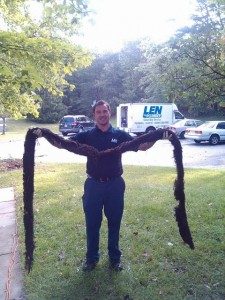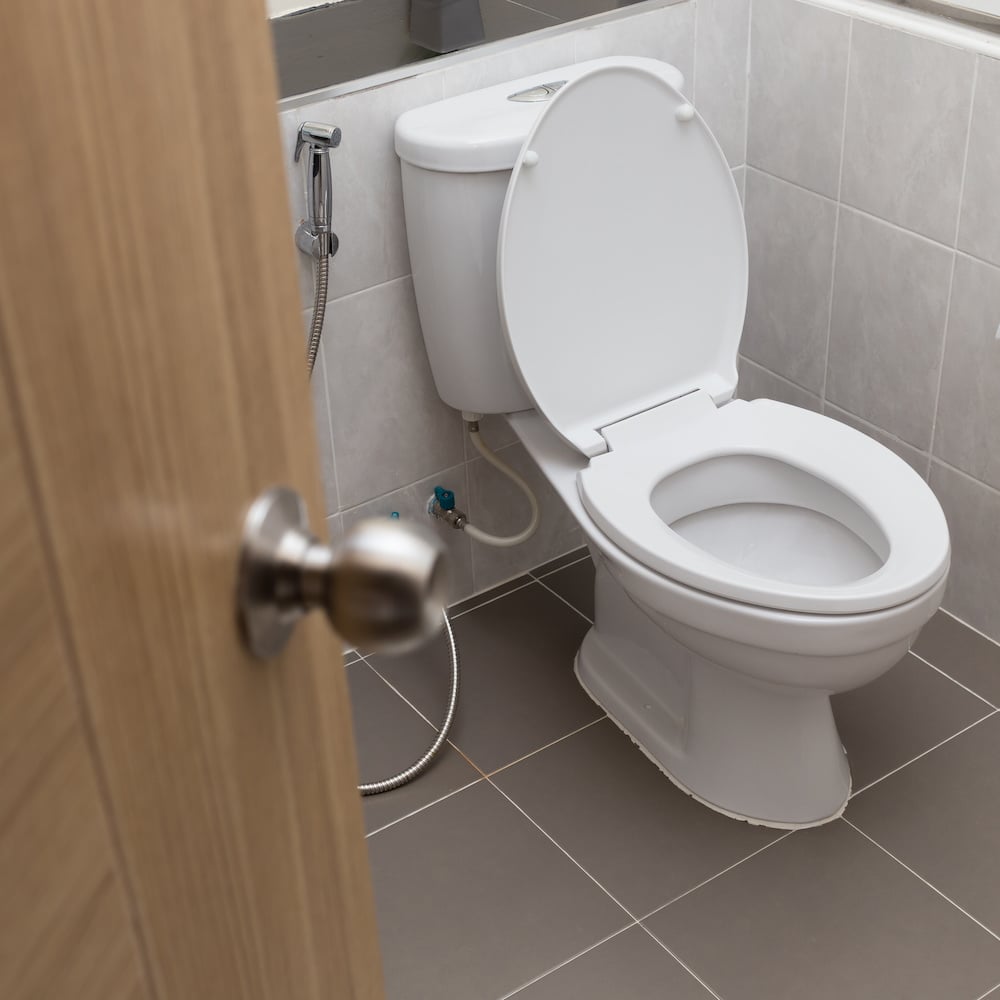A garbage disposal is a great kitchen convenience that makes food scraps go away without making a smelly, gooey mess in the waste container. But even this hardy piece of technology can clog and malfunction. So, with apologies to that close relative you’ve nicknamed “The Human Garbage Disposal,” we offer a guide to what to do if your actual disposal jams – as well as how to prevent jams in the first place!
The care and feeding of your garbage disposal
Although not a delicate piece of machinery, a garbage disposal isn’t built to handle everything you may be inclined to feed it. Here’s a rundown of the most common materials that cause indigestion.
Bones – Instead of being crushed and going through the system, bones will just keep spinning around and around with the blades. If they do manage to make it past the disposal, they won’t be able to go down the drain pipes. Instead, they’ll simply stick and potentially clog your entire system. There’s some debate about the safety of disposing of very small bones, but it isn’t worth the risk.
Fibrous/starchy fruit and vegetable peels – Banana peels contain stringy, fibrous material that can split off from the peel itself and wind around the disposal’s blades. The disposal gets more and more tangled as it spins, and may lead to severe damage. Potato peels have a high starch content, causing them to turn into a thick, soupy mush that consequently causes clogs and blockages in the pipes. Add celery, onion skins, corn husks, artichokes and asparagus to this list.
Fruit pits and nuts – Every try to cut a peach or avocado pit in half? Can’t do it, right? Neither can your garbage disposal, which also can’t do double-duty as a nutcracker.
Pasta, rice, and oatmeal – How much trouble can those little grains cause? Or soft pasta? A significant amount, when the water greatly expands them from their original size. Think about the difference between a dry and wet kitchen sponge, and you’ll get the picture. In this state, they can easily fill up the disposal trap, or block the drain or pipes.
Coffee grounds – Our colleagues at Haynes Plumbing in Harrisville, UT, describe the problems coffee grounds cause very well. “Although the grounds appear to be going down with no problem, they can actually cause a hefty amount of damage. They pile up quite quickly at the bottom of the drain, creating a thick and sludgy mass of sediment. This sludge keeps accumulating in your pipes and drains and can be very hard to get rid of. It’s a notorious culprit for clogs and other drainage issues. As appealing as the smell can be, it’s best to avoid trouble by tossing your coffee grounds in the trash or compost.”
Egg shells – Again, disposing of egg shells is the subject of debate. Some argue that the shells help keep the blades sharp; others point out that the inner membrane can cling to the edges of the disposal unit, which is not a good thing. Better to exercise caution and dispose of them in the waste basket or add to the compost pile.
Cigarette butts – We’re not going to judge or preach – except about the need to keep them out of your garbage disposal. The cigarette’s chemicals and other materials are shredded and spread throughout your drainage system. They may get stuck, leading to a clog. And if they do pass entirely through your plumbing, they’ll end up in your local water supply.
Grease and oil – Do not pour down any drain in your house! Our December 2018 blog post – “Pouring Grease Down the Sink? Don’t Do It!” – explains the many reasons why.
Can you run Drano down a garbage disposal?
Many people consider Drano the go-to quick fix for any clog. While S.C. Johnson – Drano’s parent company – says that most of the Drano product line (except Drano Kitchen Crystals) is safe for use in garbage disposals, professional plumbers don’t recommend it.
Reason? The main ingredient in all Drano products is sodium hydroxide, commonly known as caustic soda or lye. In addition to causing severe burns, this chemical can damage your pipes. When caustic soda combines with water, it produces heat. Used in a garbage disposal unit, it can combine with bleach or ammonia and release harmful fumes, as well.
There are effective alternatives that are safer for your plumbing, your health and the environment. Liquid Plumr is safe for use in garbage disposals, as its active ingredient is citric acid instead of sodium hydroxide. But for those who are very eco-minded, you can DIY by combining vinegar with baking soda.
Basic maintenance tips
To keep your garbage disposal functioning at its best, run ice cubes down periodically to prevent sludge build-up and sharpen blades. Grinding citrus peels will prevent unpleasant odors. When you are finished using your garbage disposal, briefly run the appliance with a bit of dish detergent and cold water to help keep it clean and clog-free.
Always use cold water when running the disposal, regardless of what you’re grinding. Using hot water can cause grease clogs. Even if you’re careful about not running grease down, some amount inevitably clings to or remains in food prepared using grease.
Troubleshooting your garbage disposal
If your garbage disposal goes on strike, our colleagues at Sansone in South Florida recommend the following troubleshooting checks.
Test the power outlet – This will likely be in the cabinet under the sink. Unplug the garbage disposal and plug in a food processor or blender, to see if it’s powered. If these appliances don’t turn on either, check your circuit breakers to see if the one providing electricity to your disposal has tripped. Turn it back on, then return to the kitchen to check if the garbage disposal is working.
Press the reset button – When a garbage disposal overheats, the reset button may pop out. This is the equivalent of your home’s circuit breakers tripping when overloaded. To fix it, make sure the disposal’s wall switch is set to “off” before doing anything else. Then wait a few minutes to allow it to cool off. Finally, open the cabinets underneath your sink and look for the cylinder that holds the disposal. Feel around the bottom for the red reset button and push it back in. Turn the switch back on to see if it works. If you hear a hum, something inside is jammed.
If this happens, what step you take next depends upon you level of DIY skill and confidence. If you are not comfortable taking the unit apart to locate the jam, call a plumber. If you are comfortable, Sansone and This Old House provide step-by-step instructions. Click on these links to access them.
When is it time to replace your garbage disposal?
A garbage disposal should last up to 12 years. Like every other mechanical device, it eventually wears out. Here are the signs that indicate replacement time is near.
- It clogs frequently (either the blades are getting dull or you need a larger disposal).
- You have to press the reset button often.
- Food takes longer and longer to grind.
- The unit is leaky.
- The unit is making loud noises.
The take-home message
Whether you have an issue with your garbage disposal that requires professional attention, or need a new unit, Adams and Son Plumbing is ready to help. We are a family-owned business with over 50 years in plumbing service. A state-certified plumbing contractor, we have over three generations of master plumbing experience. Contact us to learn more and schedule a service appointment.
The post Garbage Disposal Jammed? What You Need To Know! appeared first on Adams and Son Plumbing Services.



 Backups are a distinct and messy sign that something’s not right with your
Backups are a distinct and messy sign that something’s not right with your  Are funny sounds coming from your drains? Don’t ignore these sounds. A gurgling drain means business, but the good news is that there’s help available from your neighborhood emergency plumbing service in Pittsburgh, PA. So, even if the water releases from the drain while it’s making noises, you still need to call for service.
Are funny sounds coming from your drains? Don’t ignore these sounds. A gurgling drain means business, but the good news is that there’s help available from your neighborhood emergency plumbing service in Pittsburgh, PA. So, even if the water releases from the drain while it’s making noises, you still need to call for service. Solution: You need more than an emergency toilet plumber for this problem. You need specialized drain and sewer plumbing services for this job.
Solution: You need more than an emergency toilet plumber for this problem. You need specialized drain and sewer plumbing services for this job.  Flushing a water heater is one of the basic steps of cleaning the system. During a water heater flush, all the water in the tank is drained out so any sediment or other build up inside can be removed. In some situations, the tank will also need to be descaled to remove build up of limescale, one of the side effects of hard water.
Flushing a water heater is one of the basic steps of cleaning the system. During a water heater flush, all the water in the tank is drained out so any sediment or other build up inside can be removed. In some situations, the tank will also need to be descaled to remove build up of limescale, one of the side effects of hard water.


 Many of us have come to depend on the cool comfort provided by our air-conditioning systems. Air-conditioning can provide a welcome respite from even the hottest outdoor temperatures, which can be important not only for your comfort but your safety as well. However, when your air conditioner unexpectedly breaks down, it can leave you in a sticky situation, both figuratively and literally. Unfortunately, those unexpected AC failures may happen at the most inopportune moments, leaving you to sweat it out as you wait for a professional air conditioner and furnace repair service to restore your comfort level.
Many of us have come to depend on the cool comfort provided by our air-conditioning systems. Air-conditioning can provide a welcome respite from even the hottest outdoor temperatures, which can be important not only for your comfort but your safety as well. However, when your air conditioner unexpectedly breaks down, it can leave you in a sticky situation, both figuratively and literally. Unfortunately, those unexpected AC failures may happen at the most inopportune moments, leaving you to sweat it out as you wait for a professional air conditioner and furnace repair service to restore your comfort level. Likewise, a unit that is performing optimally will also run more efficiently, which will save you money on energy bills. For example, if your refrigerant levels are low, your unit won’t be able to maintain the temperature setting on your thermostat as easily. As a result, the unit will cycle on more often, and when it does it will run for longer periods. That will drive your energy costs up and leave you with increased bills at month’s end, especially during the hottest parts of the year. However, by performing routine maintenance, your HVAC professional can assess refrigerant levels and other operational factors to ensure your unit is running efficiently.
Likewise, a unit that is performing optimally will also run more efficiently, which will save you money on energy bills. For example, if your refrigerant levels are low, your unit won’t be able to maintain the temperature setting on your thermostat as easily. As a result, the unit will cycle on more often, and when it does it will run for longer periods. That will drive your energy costs up and leave you with increased bills at month’s end, especially during the hottest parts of the year. However, by performing routine maintenance, your HVAC professional can assess refrigerant levels and other operational factors to ensure your unit is running efficiently.
 To earn the Best Pick certification:
To earn the Best Pick certification: